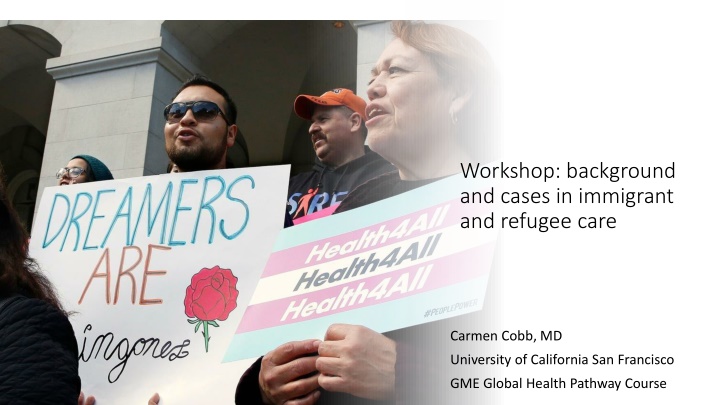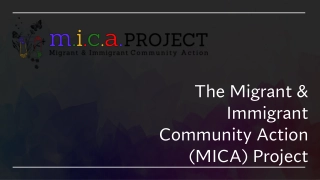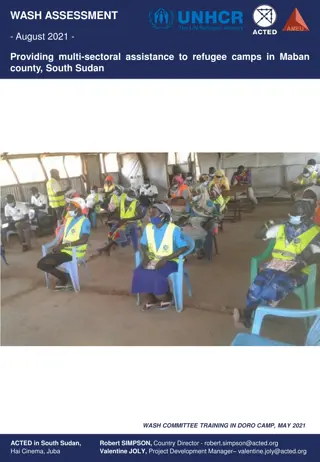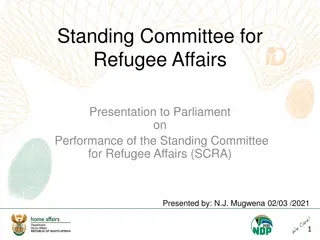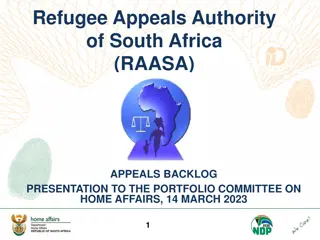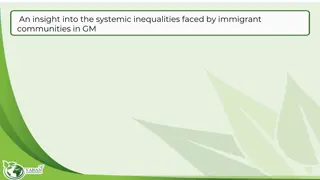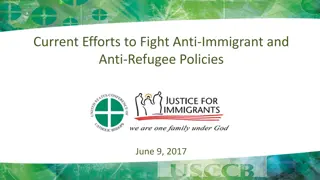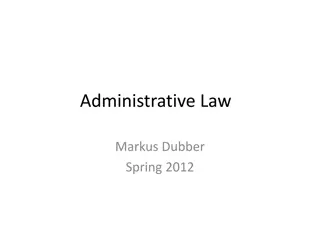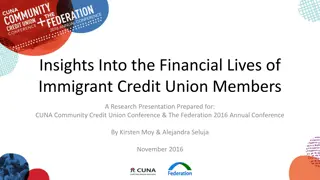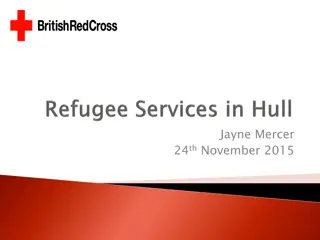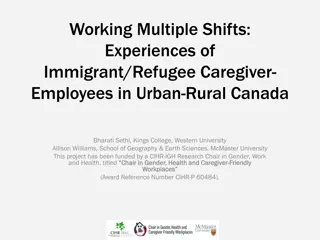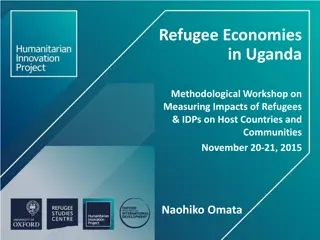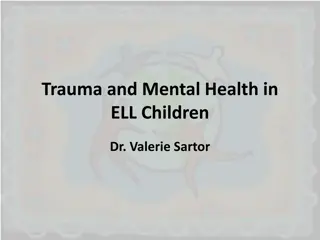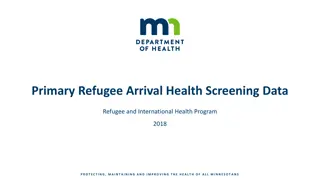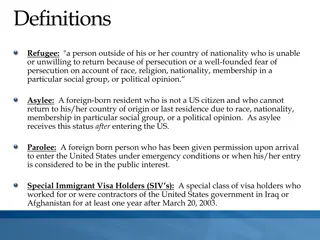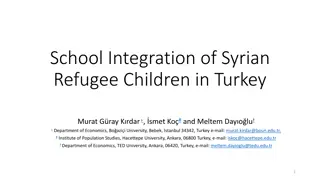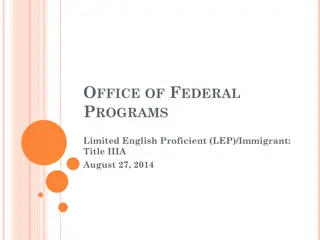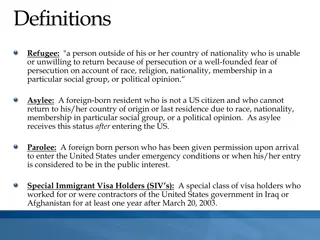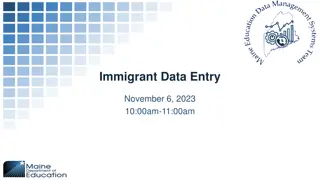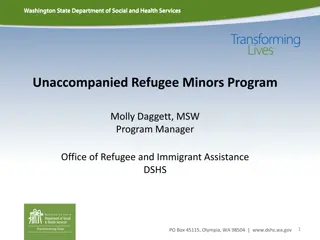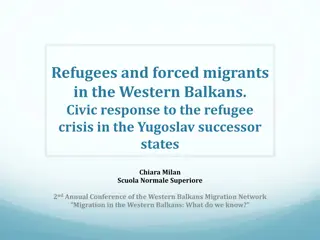Workshop on Immigrant and Refugee Care
Gain insights into immigration status concerns, health implications, and patient rights in immigrant and refugee care. Explore US policies, foreign-born populations, and pathways to lawful permanent residency. Delve into humanitarian protections for refugees and asylees.
Download Presentation

Please find below an Image/Link to download the presentation.
The content on the website is provided AS IS for your information and personal use only. It may not be sold, licensed, or shared on other websites without obtaining consent from the author.If you encounter any issues during the download, it is possible that the publisher has removed the file from their server.
You are allowed to download the files provided on this website for personal or commercial use, subject to the condition that they are used lawfully. All files are the property of their respective owners.
The content on the website is provided AS IS for your information and personal use only. It may not be sold, licensed, or shared on other websites without obtaining consent from the author.
E N D
Presentation Transcript
Workshop: background and cases in immigrant and refugee care Carmen Cobb, MD University of California San Francisco GME Global Health Pathway Course
Disclosure statements No conflicts of interests or disclosures Thanks to Dr. Adri Jim nez Bacard , MD for collaboration and background materials
Objectives Gain Acquire Integrate Gain understanding of types of immigration status, associated concerns, and barriers to care Acquire further awareness of health implications of immigration status, detention, and separation Integrate knowledge of patient rights, medical treatment options, and relationship building into case discussion
U.S. Policy: Immigration and Nationality Act Abolished national-origins quota law Annual caps on total immigration Established per-country caps Defined principles guiding U.S. policy: Family reunification Employment-based immigration Humanitarian protection Diversity in countries of origin Provided grounds for removal of foreign-born persons
U.S. Foreign- Born Population
U.S. Foreign-Born Population
Pathway to Lawful Permanent Residency Family Reunification Employment Diversity Visa Program Two thirds of annual new LPR Immediate relatives of U.S. citizens Family preference system New arrivals vs Adjustment of Status ~12% of annual new LPR ~5% of annual new LPR
Pathway to Lawful Permanent Residency Humanitarian Protection Refugee A person fleeing his or her country because of persecution or a well- founded fear of persecution on account of race, religion, nationality, membership in a particular social group, or political opinion Processed and admitted to the United States from abroad Asylum Protection to foreign nationals already in the United States or at the border who meet definition of a refugee No annual limit Source: Migration Policy Institute Refugees and Asylees are ~13% of annual new LPR.
Pathway to Lawful Permanent Residency Special Populations Cancellation of removal Substantial ties to the United States Good moral character Extreme and unusual hardship to their families in the United States Violence Against Women Act victims of abuse right to self-petition U visa victims of crime T visa victims of trafficking
Outside the Pathway to Lawful Permanent Residency Unauthorized Immigrants Overstay of non-immigrant visas Entered without inspection Temporary protected status From designated countries Deferred Action for Childhood Arrivals
Immigrant children in the U.S. Immigrant children: those who have at least one foreign-born parent First-generation: born outside the United States Second-generation: born within the United States
Children in Mixed Status Families
Children in Mixed Status Families Source: Pew Research Center
Case 1: Leti and baby Al Leti, the mother of your one-year-old patient Al, confides that she is the victim of domestic physical and emotional abuse and worries for Al s safety in the home. However, she fears leaving her husband because she recently received conditional permanent resident status through their marriage, which allowed her to relocate to the U.S. She relies on him to make her permanent status official and believes her husband will have her deported if she leaves him.
Pearls The Violence Against Women Act allows abused noncitizen spouses of LPR or U.S. citizens to self-petition for themselves or/and their abused children independently of their sponsor spouse. This is an option for noncitizen spouses with conditional lawful permanent resident status gained through family reunification process that would otherwise feel compelled to stay in an abusive relationship.
Case 2: E E is a 14-year-old boy who is new to your clinic and is accompanied by his aunt. E is originally from Honduras and was detained as an unaccompanied minor at the US- Mexico border earlier this year. After initial processing, he was released to his aunt as his sponsor and is currently pending immigration proceedings. What is E s immigration status? What additional information would help him understand his eligibility for immigration relief? What public resources are available to him?
Case 2: E As his new primary care provider, you are concerned about the potential physical and emotional health effects the journey and detention process may have had upon E. He admits to occasional marijuana and alcohol use when he wants to forget what happened to me . Some of your staff have heard Eduardo s story, and there are several other immigrant families in your practice. Your staff ask you what their personal obligations are with regards to protecting immigrant families and their information. How can you facilitate E s next steps and best advocate for him in your clinic? How do you answer your staff s questions regarding protecting information? Should you document E s immigration status in your note?
Pearls Asylee and/or special immigrant juvenile status Further information on E s experiences (ie gang violence, etc) may help find further avenues to authorized status, but it is essential to establish trust and use a trauma informed approach Affidavit legal document describing whether a patient s examination (physical or mental) and history are consistent with the case that the client describes in immigration court How can I be trained to do forensic examinations for asylum seekers? Formal training available at Physicians for Human Rights May be available at other institutions with Human Rights Clinics
Pearls Provider rights: Healthcare facilities are considered sensitive spaces Providers and staff have no obligation to disclose immigration information unless pursuant to a warrant Providers and staff have a right to remain silent if questioned regarding a patient s immigration status Documentation: Patient immigration status (as part of social history) should be protected under HIPAA However, concerns that if records are subpoenaed that immigration status may be disclosed. Documentation practices vary, best practices include minimizing documentation regarding immigration status.
Case 3: Olivia Olivia is a 4-year-old girl who is new to your clinic and is accompanied by her mother. You learn that Olivia has been to the emergency room several times in the last few months for acute asthma exacerbations. You learn from her mother that Olivia was born in the United States but has never had regularly scheduled pediatrician visits. You also learn that Olivia s mother and father were both born in Guatemala and moved to the United States over a decade ago. The family s primary income source is through her father s job in the restaurant industry. Olivia s mother confides that neither she nor her husband have an authorized immigration status and that no one in the family has health insurance. How would you describe the immigration status of this household? What is Olivia s citizenship status? How has their family status limited healthcare access for Olivia?
Case 3: Olivia Olivia s parents successfully enroll Olivia and her brother in Medicaid. Over subsequent visits, Olivia s asthma is difficult to control and requires sub-specialty care. Due to frequent hospitalizations, she has frequent school interruptions and develops learning difficulties necessitating a 504 plan. At a follow up visit, Olivia s mother informs you that her husband has been detained by immigration authorities. They are working with an immigration lawyer to file for Cancellation of Removal and asks you for a letter of support. What is a letter of support for cancellation of removal of a primary caregiver, and what information is important to include in a letter of support?
Pearls Stress and fear of healthcare encounters are a very tangible force in the lives of immigrant children and families, which have been shown to affect health outcomes Disparities in care persist, and a safe, compassionate medical home is essential Family preparedness plans are one way a family can prepare for the potential of caregiver removal, and templates are available to help families have an emergency plan in place
Pearls Toolkits are available for physicians asked to provide a letter of support to prevent parental deportation. (SEE I-PACK medicolegal references) There are certain requirements for cancellation of removal, and hardship to a child is one criterion considered, especially if there are specific health or school needs in question. Discussion with a family s immigration attorney is best practice for understanding the requirements of the letter and any specific considerations the attorney may ask you to consider including.
Case 4: M Patient is Spanish-speaking, no family is available You have access to a nurse, interpreter, and the patient. If you want to know an exam finding, perform the exam and ask for the finding out loud. Setting: An emergency department. Nurse: This is M. She is 14 years old. She is originally from Honduras and arrived here last week. She has a father and two brothers who remain in Honduras and an aunt who resides in the United States. Patient History: Maria states that her head and stomach hurt all over.
Provider Resources Physicians for Human Rights Training https://phr.org/issues/asylum-and-persecution/asylum-network-resources-linked/ Toolkits https://www.aap.org/en-us/Documents/cocp_toolkit_full.pdf Family Preparedness Plans https://www.bmc.org/programs/center-family-navigation-and-community-health- promotion/resources https://www.ilrc.org/sites/default/files/resources/family_preparedness_plan- 20180625.pdf I-PACK Ethics and Medicolegal Module Sugarprep.org/I-PACK
Resources Pews Research Center. (2015). How U.S. immigration laws and rules have changed through history. Available at: https://www.pewresearch.org/fact-tank/2015/09/30/how-u-s- immigration-laws-and-rules-have-changed-through-history/ Pews Research Center. (2019). Key findings about U.S. immigrants. Available at: https://www.pewresearch.org/fact-tank/2019/06/17/key-findings-about-u-s-immigrants/ Migration Policy Institute. (2019). Frequently requested statistics on immigrants and immigration in the United States. Available at: https://www.migrationpolicy.org/article/frequently-requested-statistics-immigrants-and- immigration-united-states American Immigration Council. (2019). How the United States Immigration System Works. Available at: https://www.americanimmigrationcouncil.org/research/how-united-states- immigration-system-works Congressional Research Service. (2018). Permanent Legal Immigration to the United States: Policy Overview. Available at: https://fas.org/sgp/crs/homesec/R42866.pdf
Resources Migration Policy Institute. (2019). U.S. Annual Refugee Resettlement Ceilings and Number of Refugees Admitted. Available at: https://www.migrationpolicy.org/programs/data-hub/charts/us-annual-refugee- resettlement-ceilings-and-number-refugees-admitted-united Congressional Research Service. (2018). Refugee Admissions and Resettlement Policy. Available at: https://fas.org/sgp/crs/misc/RL31269.pdf American Immigration Council. (2018). Asylum in the United States. Available at: Migration Policy Institute. (2019). U.S. Annual Refugee Resettlement Ceilings and Number of Refugees Admitted. Available at: https://www.migrationpolicy.org/programs/data-hub/charts/us-annual-refugee-resettlement-ceilings-and- number-refugees-admitted-united American Immigration Council. (2019). Violence Against Women Act (VAWA) Provides Protections for Immigrant Women and Victims of Crime. Available at: https://www.americanimmigrationcouncil.org/research/violence- against-women-act-vawa-immigration Child Trends. (2018). Immigrant children. Available at: https://www.childtrends.org/?indicators=immigrant- children Center for American Progress. (2017). Keeping Families Together. Available at: https://www.americanprogress.org/issues/immigration/reports/2017/03/16/428335/keeping-families- together/
